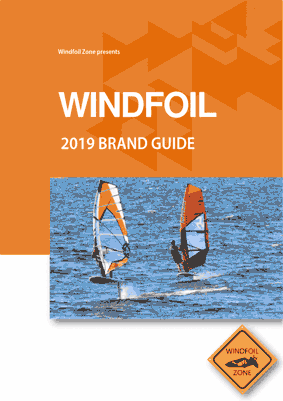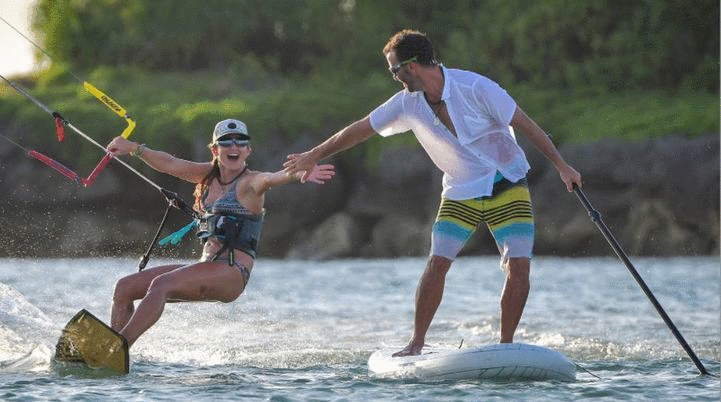How to Choose the Right Windfoil Equipment – Q&A
- .

- May 29, 2020
- 7 min read
Updated: Nov 22, 2020
Buying windfoil gear is sometimes not that easy. There are so many questions to answer. Which size? What shape? Carbon, aluminium or a mix of both? Which board?
Many of the answers depend on your budget, but also what kind of foiling you want to do! Daniel Riegler, an experienced windfoiler and kitefoiler, has helped us to answer some of the most usual questions below.
We hope this will give you more clarity. You are welcome to contact us if you still have questions, we are happy to help!

Windfoil Q&A
Question 1: Should I choose a short or a long mast
Windfoil masts come in different sizes from 40 cm to 115 cm in length. So what is the right mast size for you?
As a beginner we recommend to have a mast of (maximum) 85 cm. A short mast is safer as the distance between the water and the board gets closer. You will soon understand how it feels to stand almost one meter above the water, it’s a bit scary at first!
Short masts make it less scary and also reduces the risks when you crash (which will happen).
However, don’t choose a mast that is too short either, as it will limit your progression. When you get experienced and manage to get sustained flights, a short mast will give you less opportunity to adjust the height of your flight, and overfoiling (having the foil breaching the water) will happen regularly, with the risk of falling heavily.
That’s why 85 cm mast is a good size to start with: not to long, not too short.
When should you choose a long mast then?
Longer masts have more drag in the water if you keep the foil deep in the water, and this will impact your top speed accordingly.
However, riding with a long mast has many advantages:
It’s easier to ride as it allows to better adjust the distance between board and water level, which is particularly useful when you sail in the open sea with some swells.
You can sail more upwind.
It’s easier to learn moves like the foiling jibe or even downwind 360 as you can use the height of the foil to keep the momentum at the end of the move.
Question 2: How long of a fuselage should I choose?
The quick answer is that long fuselages are made to create a more stable ride, and primarily made for slalom and course racing foilers.
Short fuselages are less stable and more difficult to control at high speeds, but it gives also more sensations of freedom as it can help you easily change the height, direction, turn or jump. This is ideal for a more freeride or even freestyle type of foiling.
You can read more about the different types of foiling in this article.

Question 3: Should I buy a carbon or aluminium foil?
It really depends on your budget: Carbon foils are stiffer than aluminium foils and you will feel the difference, but they are also much more expensive. However, aluminium foils are perfect at the beginning as you are not looking for performance, but just want to get your first flight sensations.
When you become a more advanced foiler, chances are that you will decide to invest in a carbon foil.
Question 4: Which front wing and backwing sizes should I buy?
One of the biggest problems is that many people want to start with race foils because they have the ambition to go fast and race in the future.
You can of course learn windfoiling with a race foil, but it will take you longer to learn and you may experience heavier crashes. We usually recommend learning on a freeride foil: it gives an early lift, stable flight, and relatively low speed, which is good for the safety aspect.
Daniel has a lot of experience with Moses Foils and after a lot of testing of all the different parts of the foils, he gives you his best tips of set-up according to your level. I have more experience with Slingshot Foils and give you my 10 cents. Many other brands are of course developing great freeride kits, and those recommendations will also apply to them.
Beginner set-up:
Buy a front wing with minimum 1000 cm2 area! it’s important that the foil feels safe, is easy and friendly to learn on, and has a large front wing that will give you all that even if it will limit your top speed.
With a large front wing, you can also use smaller boards and sails, which is always nice. Speed will come later (if you want) by upgrading your foil equipment and/or improving your technique. Enjoy the fun side of foiling at low speed with a freeride kit!

A large front wing also gives you a low stall speed (i.e. the minimum speed needed to keep the board flying) which will help you to complete your first flying jibes.
Two product recommendations: Daniel recommends a front wing like the Moses 790 (1550 cm2), which is really one of the easiest foils to learn on. I personally love the Slingshot Infinity 76 wing which is a real all-rounder from 10 to 25 knots. Heavier riders may prefer the Slingshot Infinity 84 wings which gives more lift than the 76.
Freestyle set-up:
The best foil for freestyling is arguably the Moses Freestyle foil, developed together with Balz Müller, the foilstyle guru. Freestyling with a foil has always been a challenge until now as we have heard of many broken wings and masts due to hard landings.
Daniel met Balz Müller recently and he told him that he still hasn’t broken any single mast yet, despite the impressive intensity of his foiling style. So this kit is really made for it!
A smaller front wing surface (like the W720 with 746 cm2) will help you to get more speed to accomplish your tricks.
Slalom racing set-up (PWA style):
For slalom racing you definitely need a smaller wing than for course racing. A too big of a wing will produce too much lift in high speed.
On the other hand, the front wing should not be too small because you want to fly early on the starting line. The Moses W800 wing is perfect for a downwind racing course. You can race with high speed but still have a lot of control during the jibes.

Course racing (Olympic style):
The aim is mostly to get as much upwind and downwind as you can. Wing sizes between 900 cm2 and 1100 cm2 are the most commonly used sizes.
Combined with a long fuselage, you will be able to do crazy angles upwind. One common problem with many wings though is the ability to put enough pressure when riding downwind, which makes you lose precious time. The best wings will combine excellent upwind and downwind performance and will help you win races.
Daniel’s recommendation is the Moses W1000, the fastest wing he rode so far.

Question 5: Which foilboard should I buy? Big size foilboard vs small freeride/freestyle boards.
What style of foiling are you most interested in? Just think about it, this is the first choice you have to make. Either you want to race foil and go fast, or you prefer to explore the fun side of foiling and don’t care about breaking speed records.
If you are a foil beginner, the easiest way is to choose a relatively big board (at least 130 L). It will feel more comfortable than a small board with less volume. It’s important that you choose a board with a reinforced foilbox (Foil-ready box).
This is a big discussion as several brands offer powerbox head with a spreader (or load plate). You need to know that this system can work, but it can break as well, so you take a risk. You can also ask your local shaper to change the box of your board to a reinforced one, which is a smaller investment than buying a brand new foil board.
You should not start with a dedicated race board: Race boards have a very light and fragile construction. As every beginner, you will for sure crash a few times on the nose.
Even with protection like the Surfbent or the Unifiber nose protection, your board may suffer from the repeated crashes. Take a basic epoxy model first. It’s cheaper and more solid than a full carbon board, even if it’s slightly heavier.
Daniel’s recommendation: JP Australia EPS versions are good all-rounders and bullet proof compared to the carbon versions.
We always recommend beginners (and even more advanced foilers) to protect the board from catapult crashes. Surfbent has proven to be a good way to protect the nose of your board, even if it can not prevent 100% of the crashes. Our experience is that is that the big hits aren't as big and the small hits usually go unnoticed.
If you are most interested in course racing, then there is just one way to do that: Buy a 100 cm board, as wider boards will enable you to go much more upwind than a narrow board as you can push more on the foil by putting more pressure on the rail of the board.
Foil slalom boards are not as wide as the course racing boards, as there is a maximum width of 91 cm decided by the PWA, and slightly less performant upwind. These boards have enough volume for very light wind days (down to 5-6 knots) and they are made to be super-efficient on downwind racing courses.

If the freeride style is more your kind of foiling, or if you even want to start freestyling and try tricks, buy a smaller board. The best size for freeride boards is between 110 L and 150 L. The smaller the board, the more skills and technique it will require. Again, if you are a beginner, don’t take a too small of a board. You’d rather start with a big board and switch to a smaller board when you improve your foiling.
We hope that this quick Q&A will help you choose the right equipment for you.
Again, don’t hesitate to contact us if you have any questions, we are more than happy to help.
Thanks also to Daniel Riegler for sharing his expertise with us. You can follow him on Instagram @daniel.riegler.




















Comments